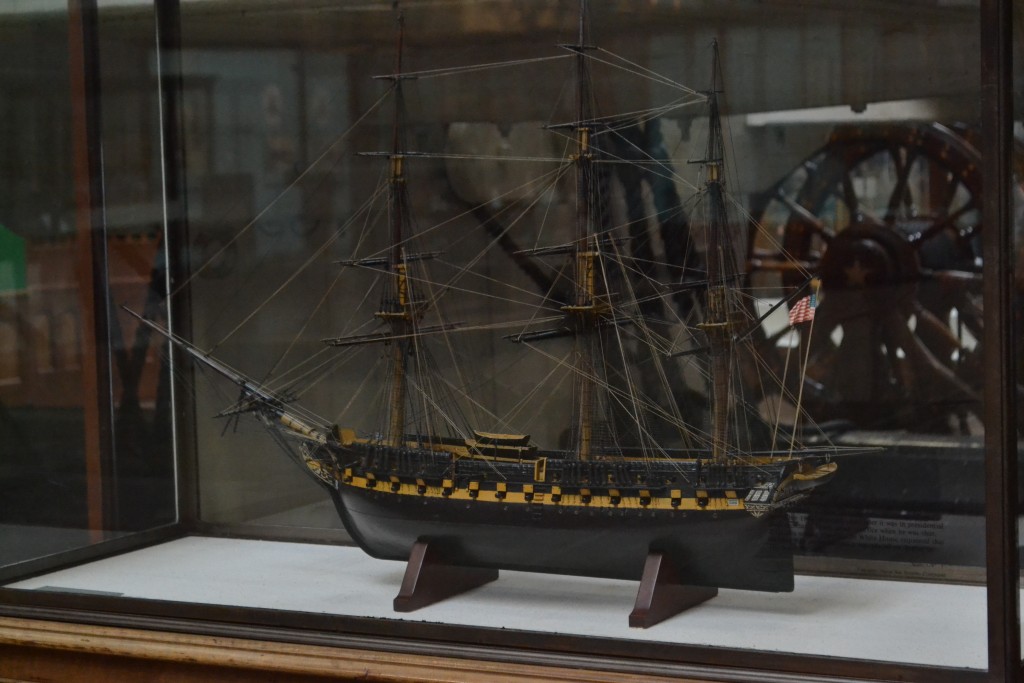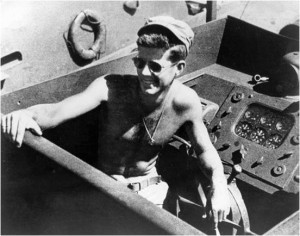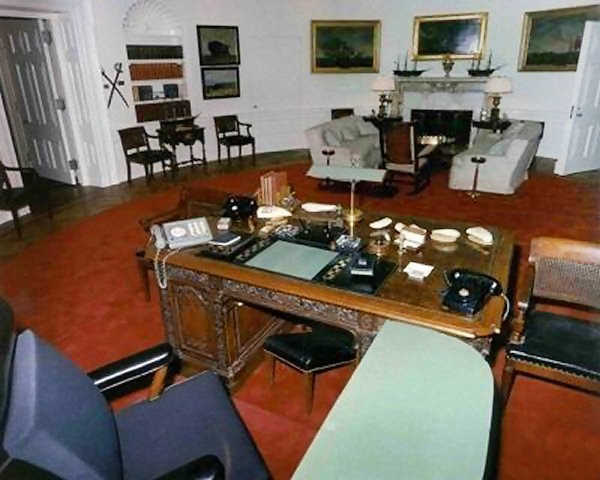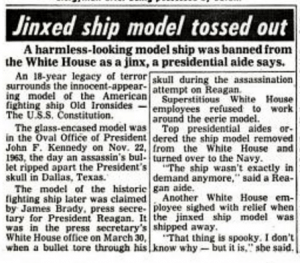
Constitution model on display at the National Museum of the United States Navy (NHF Photo/Matthew Eng/Released)
“We are tied to the ocean. And when we go back to the sea — whether it is to sail or to watch it — we are going back from whence we came.”
– President John F. Kennedy, September 1962
The last thing you might think about after a beloved U.S. President is shot is where his ship models will go. If you were as avid a collector as John F. Kennedy was, however, it was very important. One such model currently on display at the National Museum of the United States Navy has an interesting and ominous tie to both Kennedy and White House history.
The Young Man and the Sea
John F. Kennedy had a lifelong relationship with the sea. As a young officer in the U.S. Navy, Kennedy one worldwide fame for his heroic actions as the skipper of PT-109 during World War II. That universal acclaim eventually began a political career that catapulted him from public office to the White House, where he adorned the Oval Office with a maritime/naval theme as a testament to his coastal ties. Among the more recognizable artifacts now currently in the John F. Kennedy Presidential Library and Museum collection are several pieces of scrimshaw, a Fisherman’s prayer plaque, notable paintings of Navy battles, a ship’s clock/barometer,Commodore Barry’s flag, and of course, numerous ship models.

110529-O-ZZ999-007
FILE PHOTO (circa 1943) Lt.j.g. John F. Kennedy aboard the PT-109. (Photo courtesy the John F. Kennedy Presidential Library and Museum, Boston/Released)
Kennedy had a passion for ship models. He and his staff corresponded regularly with model ship designers about their work, often receiving the help of longtime friend Kirk LeMoyne “Lem” Billings to seek out his favorite ships for his personal collection. The JFK Presidential Museum and Library has an entire folder of correspondence between Kennedy, Billings, and several model makers about prospective purchases. Among the collection today are the Danmark, Sea Witch, and Wasp. These ships are clearly seen in many photographs of Kennedy working in the Oval Office.
The ship he admired the most, however, was USS Constitution. His ties to the ship are as long and tied together as the ship’s rigging. As a young boy, Kennedy was taken to visit USS Constitution in Charlestown, Massachusetts by his grandfather, John F. Fitzgerald. Fitzgerald helped save the ship from demolition back in 1896 while serving as a Massachusetts Congressman. Kennedy’s office at the White House also included a set of bookends with replica models of 24-pounder cannons used aboard USS Constitution. The working replica bookends were made by Oscar Lee Richardson.
He even used the ship for political purposes early on in his Presidency. Under the guidance of Lem Billings, Kennedy famously presented a model of her to Soviet Premier Nikita Kruschev during a luncheon at the Vienna Summit in June 1961. The model represented the relationship of the old style of warfare to the more current nuclear threat, hoping its symbol would assure no such exchange would occur.
He loved the ship so much that he had the White House Naval Aide, Captain Tazewell Shepard, Jr., write a letter to the Secretary of the Navy about the possibility of sailing Constitution from Boston to the 1964 World’s Fair in New York City.
Captain Shepard ended the letter to SECNAV Fred Korth with a simple and to the point question:
“In essence, the President would like to know: ‘Is it feasible, and what would it cost.”’
Ultimately, the Navy decided that the ship at the time was not in good enough of condition to make the trip to New York. According to one naval advisor, “the President would certainly bear the responsibility and Massachusetts citizens would have another Tea Party” should she be damaged in transit.
Although he could not convince the Navy to sail Constitution to the World’s Fair, he did have a model of the ship in the Oval Office. Although it cannot be completely confirmed at this time, most sources say the model of Constitution was placed on the mantle in the Oval Office. In Grace and Power: The Private World of the Kennedy White House, author Sally Bedell Smith recalled how journalist and painter William Walton “found a model of the frigate Constitution and two paintings of the ship in battle” for display in the oval office. This could perhaps be the model in question. There are several photographs that corroborate this, courtesy of the JFK Museum and Library.

View from behind the President’s desk in the Oval Office, White House, Washington, D.C. (JFK Presidential Library and Museum/Image # JFKWHP-KN-C18712-A)
If this is true, the model would be placed directly across the room from Kennedy’s Resolute desk near the doorway. It would a main focal point to the new redecoration scheme of the office in 1963. The carpet and decor remained largely the same since Truman’s Presidency in the 1940s, and the new face of the American people wanted to reflect a new direction. Kennedy himself had a flair for decoration and style, largely due in part to his trend-setting First Lady, Jacqueline Kennedy Onassis. He ordered a major change in design and redirection during his time in office. The new redesign of the Oval Office was just being completed when the Kennedy’s arrived in Dallas in November 1863. By the time Mrs. Kennedy returned from the traumatic events, the entirety of the office was dismantled, including the Constitution model.

1963 Oval Office Renovation (Image: Kennedy Library/Viewed on www.whitehousemuseum.org)
Interestingly enough, little evidence online suggests the model’s connection to the President. If you views the archives of the JFK Presidential Library and Museum, you will find little mention of it. There are numerous items to view in their digital exhibit of Oval Office artifacts, but the model is not amongst those previously mentioned. Most descriptions of the model is merely anecdotal. Photographs are too out of focus or small in resolution to fully confirm its place inside the office. Personal memoirs of those closest to the President also yield little confirmation. A fabulous photo spread done by Look Magazine photographer Alan Stanley Tretick (the same that published the famous image of John F. Kennedy, Jr. under the Resolute Desk) yields incomplete results. Despite this, it is a fact that the model was present in the White House at the time of the assassination in 1963.
The model changed hands over the years, eventually making it to the office of Reagan Press Secretary James Brady. Brady was critically wounded during the attempted assassination of President Ronald Reagan in 1981. Brady died in 2014 in large part to the complications sustained from his wounds during the 1981 attempt.
A Cursed Ship?
Last year, U.S. News & World Report picked up on the curious connection between the Constitution model, Kennedy, and the White House, and wrote a story on their website. Dubbed the “Black Constitution,” reporter Nikki Schwab interviewed Captain Henry J. Hendrix, then Director of the Naval History and Heritage Command, about the ship. Captain Hendrix told the story about the ship in the news article and commented how the White House returned the ship to the Navy and the possession of Curator of Ship Models, Naval Sea Systems Command after 1981. “I wouldn’t have it in my office, for instance,” said Hendrix in the interview. An article in the 1 December 1981 edition of the Weekly World News of all places ran a brief article with the title “Jinxed Ship Model Tossed Out.” In the article, one aide to Reagan is quoted with saying that “the ship wasn’t exactly in demand anymore.” Another individual commented that the model “was spooky [. . .] I don’t know why – but it is.”
The 1/8”:1’ scale ship now resides in front of the Constitution fighting top at the front of the National Museum of the United States Navy in Washington, D.C. A small description on the model case perfectly describes the model’s eery connection to an American tragedy:
“This exquisite model was on display in the Oval Office when President John F. Kennedy was assassinated on 22 November 1963. Eighteen years later it was in presidential press secretary, James Brady’s office when he was shot. After this second tragedy, the White House requested that the model be removed, and it was placed on display in The Navy Museum.”
The model, alongside countless others inside one of Washington, D.C.’s best kept secrets, is free to visit.



Bob
Bob